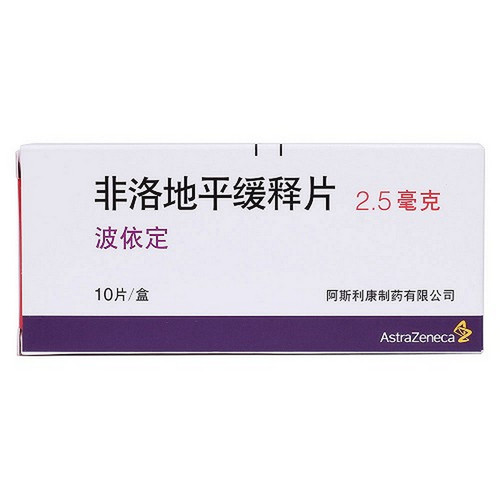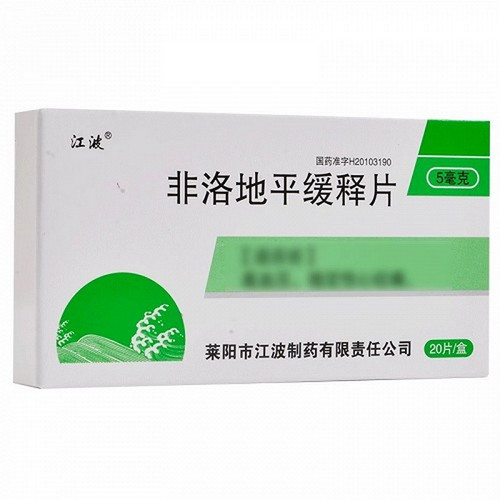Product Overview
[Drug Name]
Generic Name: Felodipine Sustained-Release Tablets
Trade Name: Feiluodiping
English Name: Felodipine Sustained-Release Tablets
Chinese Pinyin: Feiluodiping Huanshipian
[Ingredients]
The main ingredient is felodipine.
[Properties]
This product is a film-coated tablet. The 2.5 mg dose is yellow, the 5 mg dose is pink, and the film coating is removed to reveal a white color. The main ingredient and its chemical name are: felodipine; Chemical name: 2,6-dimethyl-4-(2,3-dichlorophenyl)-1,4-dihydro-3,5-pyridinedicarboxylic acid methyl ethyl ester. Molecular formula: C18H19Cl2NO4
[Indications]
Hypertension, angina pectoris.
[Dosage and Administration]
The dosage should be individualized. The recommended starting dose is 2.5 mg once daily. The usual maintenance dose is 5 or 10 mg once daily. The dose can be increased if necessary, or other antihypertensive medications can be added. The tablets should be taken in the morning with water. For oral administration, dosage should be individualized. The tablet should be swallowed in the morning with water. Do not break, crush, or chew the tablet.
1. Treatment of Hypertension: The recommended starting dose is 5 mg once daily, with a typical maintenance dose of 5 or 10 mg once daily. The dose may be reduced or increased based on patient response, or other antihypertensive medications may be added. Dosage adjustments should generally be made at least every two weeks.
2. Treatment of Angina: The recommended starting dose is 5 mg once daily, with a typical maintenance dose of 5 or 10 mg once daily.
[Adverse Reactions]
Facial flushing, palpitations, dizziness, and fatigue may occur in a small number of patients. Ankle edema due to capillary dilation may also occur. Mild gingival swelling has been reported in patients with gingivitis or periodontitis. Like other vasodilators, felodipine extended-release tablets may cause facial flushing, palpitations, dizziness, and fatigue in some patients. Most reactions are dose-related, often occurring upon initiation or dose increase. These adverse reactions are generally circadian and resolve gradually over time. Like other dihydropyridine calcium channel blockers, this drug may cause dose-related ankle edema (due to pre-telangiectasia). Mild gingival swelling has also been reported in patients with gingivitis or periodontitis, but this can be avoided or reversed with dental care. Skin reactions such as rash and pruritus have also been reported. 1. Common (=1%): Neurological: Headache; Skin: Flushing; Vascular: Peripheral edema; 2. Uncommon (=1 per million, 1%): Cardiovascular: Tachycardia, Palpitations; Neurological: Dizziness, Paresthesia; Digestive: Nausea, Abdominal Pain; Skin: Rash, Itching; General: Fatigue. p=3. Rare (1‰, = 1/10,000): Cardiovascular: Syncope; Digestive: Vomiting; Musculoskeletal: Arthralgia, Myalgia; Psychiatric: Impotence/Sexual Dysfunction; Skin: Urticaria. 4. Very Rare (1/10,000): Digestive: Gingival hyperplasia, gingivitis; Liver: Increased hepatic enzymes; Skin: Photosensitivity, leukocytoclastic vasculitis; Urinary: Frequent urination; General: Allergic reactions such as angioedema, fever.
[Contraindications]
Pregnancy (including early pregnancy) and hypersensitivity to this product. Hypersensitivity to felodipine or any of its components, patients with decompensated heart failure, acute myocardial infarction, unstable angina, and pregnant women.
[Precautions]
1. Similar to other vasodilators, felodipine may rarely cause significant hypotension, which may cause myocardial ischemia in susceptible individuals. Use with caution in patients with hypotension. 2. Clinical trials have shown that doses exceeding 10 mg per day can enhance the antihypertensive effect, but also increase the incidence of peripheral edema and other vasodilatory adverse events. 3. In patients with impaired liver function, felodipine plasma clearance is decreased, leading to elevated blood concentrations. Therefore, a starting dose of 2.5 mg once daily is recommended. Blood pressure should be monitored carefully during dose adjustments in these patients. Patients with renal insufficiency generally do not require dose adjustment. 4. Women considering pregnancy should discontinue use. This product should be taken orally on an empty stomach or with a small, bland meal. The tablet should be swallowed whole and not crushed or chewed. Maintaining good oral hygiene can reduce the incidence and severity of gingival hyperplasia. 5. Felodipine should not be used during pregnancy. Although felodipine can be detected in breast milk, therapeutic doses of felodipine have no adverse effects on infants in breastfeeding mothers. 6. In patients over 65 years of age, felodipine plasma clearance is decreased, leading to elevated blood concentrations. Therefore, a starting dose of 2.5 mg once daily is recommended. Blood pressure should be monitored carefully during dose adjustments in these patients.
[Use in Special Populations]
Precautions for Children:
Experience with this drug in children is limited.
Precautions for Pregnancy and Lactation:
Pregnancy (including early pregnancy).
Precautions for Elderly:
The blood concentration of this drug increases with age. Therefore, the recommended initial dose for elderly patients (over 65 years old) is 2.5 mg daily, with dose adjustments based on individual response.
[Drug Interactions]
1. Concomitant use of certain drugs that interfere with the cytochrome P450 3A4 enzyme system may affect the blood concentration of dihydropyridine calcium antagonists, such as felodipine. Hepatic enzyme inhibitors (such as cimetidine, erythromycin, itraconazole, ketoconazole, and certain flavonoids found in grapefruit juice) may increase the blood concentration of felodipine. Hepatic enzyme inducers (such as phenytoin, carbamazepine, rifampicin, and barbiturates) may decrease the blood concentration of felodipine. 2. Felodipine does not affect the blood concentration of cyclosporine. 3. Although felodipine has a high degree of plasma protein binding, it does not affect the binding of other highly plasma protein-bound drugs (such as warfarin). 4. Concomitant use of this product with digoxin has not been shown to significantly alter the pharmacokinetic behavior of digoxin in patients with heart failure. 5. Other drugs, such as indomethacin or spironolactone, have no significant interactions with this product.
[Pharmacological Actions]
1. Pharmacology: This product is a dihydropyridine calcium channel blocker that reversibly competes with nitrendipine and/or other calcium channel blockers for dihydropyridine binding sites. It blocks voltage-dependent Ca2+ currents in vascular smooth muscle and cultured rabbit atrial cells, and blocks K+-induced portal vein contracture in rats. In vitro studies have demonstrated that felodipine selectively inhibits vascular smooth muscle over myocardial function; negative inotropic effects have been detected in vitro, but not in whole animals. Felodipine reduces peripheral vascular resistance and blood pressure. This pharmacological effect is dose-dependent and is accompanied by a reflex increase in heart rate. The antihypertensive effect of felodipine is dose-dependent and positively correlated with plasma concentration. A reflex increase in heart rate may occur during the first week of use, but this effect diminishes over time. Long-term administration may increase heart rate by 5-10 beats/minute, an effect that can be counteracted by beta-blockers. Felodipine, when used alone or in combination with beta-blockers, does not affect the PR interval on the electrocardiogram. Clinical and electrophysiological studies have shown that felodipine, when used alone or in combination with beta-blockers, has no significant effect on cardiac conduction (PR, P-Q, and H-V intervals). Antihypertensive treatment with felodipine is associated with significant regression of pre-existing left ventricular hypertrophy. In clinical trials of hypertensive patients without left ventricular dysfunction, no clear negative inotropic effect was observed. In clinical trials of hypertensive patients, felodipine was found to increase plasma norepinephrine levels. Felodipine reduces renal tubular reabsorption of filtered sodium, resulting in a natriuretic and diuretic effect. This eliminates the sodium and water retention common with other vasodilators. Felodipine does not affect daily potassium excretion. Felodipine reduces renal vascular resistance. The normal glomerular filtration rate is unchanged. In patients with impaired renal function, the glomerular filtration rate may increase. Felodipine does not affect urinary albumin excretion. In patients receiving cyclosporine after renal transplantation, felodipine can lower blood pressure, improve renal blood flow, and improve glomerular filtration rate. Felodipine can also improve early graft function. Mild diuresis, increased natriuresis, and increased potassium levels can be seen in the first week of treatment, and electrolyte levels are not affected in short-term or long-term treatment. Felodipine exerts its antianginal and anti-ischemic effects by improving myocardial oxygen supply. Felodipine reduces coronary vascular resistance by dilating epicardial arteries and arterioles, increasing coronary blood flow and myocardial oxygen supply. Felodipine can effectively relieve coronary vasospasm. The decrease in peripheral blood pressure caused by felodipine reduces left ventricular afterload and myocardial oxygen demand. In stable exertional angina, felodipine can improve exercise tolerance and reduce angina attacks. Felodipine can reduce the occurrence of symptomatic and painless myocardial ischemia in patients with vasospastic angina. Felodipine can be used alone or in combination with beta-blockers to treat stable angina. Felodipine is effective and well-tolerated regardless of age and race, even in patients with congestive heart failure, asthma and other obstructive lung diseases, renal impairment, diabetes, gout, hyperlipidemia, Raynaud's disease, or renal transplant recipients. 2. Toxicology: Carcinogenicity studies: In a two-year carcinogenicity study, male rats administered felodipine at 7.7, 23.1, or 69.3 mg/kg daily doses observed a dose-dependent increase in the incidence of benign interstitial cell tumors (Leydig cell tumors). However, this effect was not observed in a similar study in mice administered 138.6 mg/kg daily (28 times the maximum recommended human dose). At the doses used in the two-year rat study, felodipine decreased testosterone levels in rats and correspondingly increased serum luteinizing hormone. Leydig cell tumor formation may be a secondary effect of these hormones, but this has not been observed in humans. In the same rat study, the incidence of focal squamous cell hyperplasia in the esophageal groove increased with increasing dose in both male and female rats at all dose groups compared to the control group. No other drug-related esophageal or gastrointestinal pathological changes were observed in rats. Felodipine was not found to cause cancer in mice after 80 weeks of daily administration at 138.6 mg/kg (28 times the maximum recommended human dose) in male mice and 99 weeks in female mice. Mutagenicity: Felodipine showed no mutagenic activity in the in vitro Ames microbial mutagenicity assay and the mouse lymphoma forward mutation assay. No clastogenic effects were observed in the in vivo mouse micronucleus assay or the in vitro human lymphocyte chromosome aberration assay at an oral dose of 2500 mg/kg (506 times the maximum recommended human dose). Reproductive toxicity: Felodipine did not significantly affect fertility in male and female rats administered daily doses of 3.8, 9.6, or 26.9 mg/kg. Teratological studies of pregnant women with felodipine at doses of 0.46, 1.2, 2.3, and 4.6 mg/kg per day (0.4-4 times the maximum recommended human dose) showed abnormalities in digital digits, including decreased size and extent of ossification of the terminal digits, in fetal rabbits. The frequency and severity of these changes were dose-related and occurred even at the lowest dose. Similar abnormalities were not observed in fetal rats. Teratological studies in rhesus monkeys did not show decreased size of the terminal digits, but approximately 40% of fetuses had terminal digit malposition. Studies in rats administered felodipine at doses exceeding 9.6 mg/kg per day (4 times the maximum recommended human dose) showed prolonged labor and increased rates of embryonic and neonatal mortality.
Storage: Store in a dark, airtight container.
Specifications: 5 mg x 30 tablets
Packaging: Box
Expiry Date: 24 months. Approval Number: National Medicine Standard H20030415
Manufacturer: AstraZeneca Pharmaceuticals (China) Co., Ltd.








